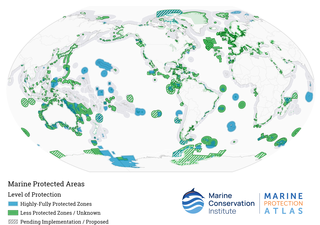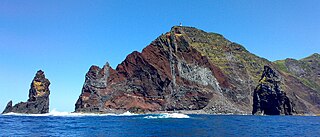Related Research Articles

The European Environment Agency (EEA) is the agency of the European Union (EU) which provides independent information on the environment.

Environmental laws are laws that protect the environment. This includes environmental regulations; laws governing management of natural resources, such as forests, minerals, or fisheries; and related topics such as environmental impact assessments.

Protected areas or conservation areas are locations which receive protection because of their recognized natural, ecological or cultural values. Protected areas are those areas in which human presence or the exploitation of natural resources is limited.

The International Union for Conservation of Nature (IUCN) is an international organization working in the field of nature conservation and sustainable use of natural resources. It is involved in data gathering and analysis, research, field projects, advocacy, and education. IUCN's mission is to "influence, encourage and assist societies throughout the world to conserve nature and to ensure that any use of natural resources is equitable and ecologically sustainable".
This is an index of conservation topics. It is an alphabetical index of articles relating to conservation biology and conservation of the natural environment.

Marine protected areas (MPA) are protected areas of seas, oceans, estuaries or in the US, the Great Lakes. These marine areas can come in many forms ranging from wildlife refuges to research facilities. MPAs restrict human activity for a conservation purpose, typically to protect natural or cultural resources. Such marine resources are protected by local, state, territorial, native, regional, national, or international authorities and differ substantially among and between nations. This variation includes different limitations on development, fishing practices, fishing seasons and catch limits, moorings and bans on removing or disrupting marine life. In some situations, MPAs also provide revenue for countries, potentially equal to the income that they would have if they were to grant companies permissions to fish. The value of MPA to mobile species is unknown.
The UN Environment Programme World Conservation Monitoring Centre (UNEP-WCMC) is a collaboration centre of UN Environment Programme, based in Cambridge in the United Kingdom. UNEP-WCMC has been part of UN Environment Programme since 2000, and has responsibility for biodiversity assessment and support to policy development and implementation. The World Conservation Monitoring Centre was previously an independent organisation jointly managed by IUCN, UN Environment Programme and WWF established in 1988. Prior to that, the centre was a part of the IUCN Secretariat.
Maderas del Carmen is a biosphere reserve in the northern Mexican state of Coahuila.

An Indigenous Protected Area (IPA) is a class of protected area used in Australia; each is formed by voluntary agreement with Indigenous Australians, and declared by Aboriginal Australians and Torres Strait Islander representative organisations. Each is formally recognised by the Australian Government as being part of its National Reserve System. The areas may comprise land and sea, and are managed by Indigenous groups for the conservation of biodiversity. Managing IPAs also helps to protect the cultural values of their country for future generations, and has benefits for Indigenous health, education, economic and social cohesion.
Kep National Park is a national park in Cambodia's Kep Province that was established in 1993 and covers an area of 66.64 km2 (25.73 sq mi) The nearest town lies at Kep.

There are at least seven nature reserves in Jordan. In 1966, the organization that would later start Jordan's nature reserves, the Royal Society for the Conservation of Nature, was founded. RSCN's first efforts involved bringing back severely endangered species. In 1973, RSCN, was given the right to issue hunting licenses, giving RSCN an upper hand in preventing extinction. The first step was the founding of Jordan's first nature reserve, Shaumari Wildlife Reserve, in 1975. The primary purpose was to create means to breed endangered species, specifically: the Arabian oryx, gazelles, ostriches and Persian onagers in their natural environment.

Abashiri Quasi-National Park is a quasi-national park in Japan. The park protects the waters and surrounding coastline of the lakes and lagoons along the Sea of Okhotsk on Hokkaidō. This includes such lakes as Lake Abashiri and Lake Notoro as well as Lake Tōfutsu and Lake Saroma. Lake Saroma is the fourth largest lake in Japan. Most of the park lies within the limits of Abashiri in Abashiri Subprefecture of northeastern Hokkaidō.
Niseko-Shakotan-Otaru Kaigan Quasi-National Park is a quasi-national park in the Shiribeshi Subprefecture of Hokkaido, Japan. On the coast of the Sea of Japan, there is a Marine Protected Area covering the west and north coast of Shakotan peninsula from Kamoenai to Otaru. The park also protects the area around the Mount Raiden and Niseko Volcanic Groups. Niseko-Shakotan-Otaru Kaigan Quasi-National Park was established in 1963.

The World Database on Protected Areas (WDPA) is the largest assembly of data on the world's terrestrial and marine protected areas, containing more than 260,000 protected areas as of August 2020, with records covering 245 countries and territories throughout the world. The WDPA is a joint venture between the United Nations Environment Programme World Conservation Monitoring Centre and the International Union for Conservation of Nature World Commission on Protected Areas.

IUCN protected area categories, or IUCN protected area management categories, are categories used to classify protected areas in a system developed by the International Union for Conservation of Nature (IUCN).

The Rosais Islets are two uninhabited rocky islets located just off the extreme northwestern coast of the island of São Jorge in the Portuguese archipelago of the Azores.

Ballynafagh Lake is a shallow alkaline lake, located approximately 2 km (1.2 mi) north-west of the village of Prosperous in County Kildare, Ireland. It is designated as a special area of conservation (SAC) and protected under European Union and Irish legislation. It is one of the European protected nature sites that comprise the Natura 2000 network. It is a short distance north of the Ballynafagh Bog.
References
- ↑ "Environmental Terminology and Discovery Service". European Environment Agency. Archived from the original on 2015-12-21. Retrieved 2012-07-17.
- ↑ "Eionet Data Dictionary. View dataset definition: CDDA". European Environment Agency. Retrieved 2012-07-17.
- ↑ "EUNIS-sites: Common Database on Designated Areas". Eionet - European Topic Centre on Biological Diversity. Archived from the original on 2016-03-05. Retrieved 2012-07-17.
- ↑ "Welcome to EUNIS biodiversity database - find species, habitats and sites across Europe". European Environment Agency. Retrieved 2012-07-17.
- ↑ "An ongoing process". MAIA. Retrieved 2015-06-02.